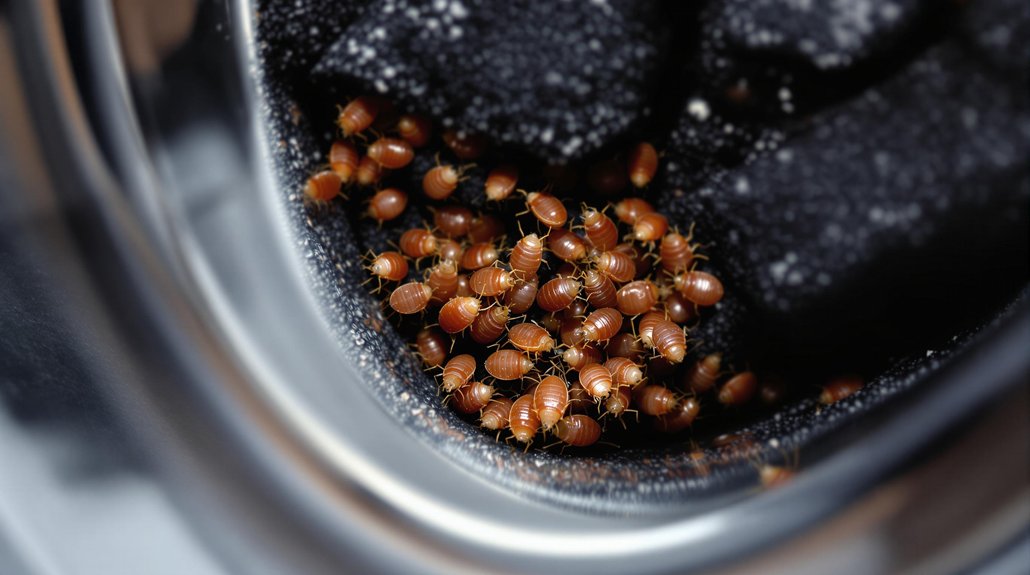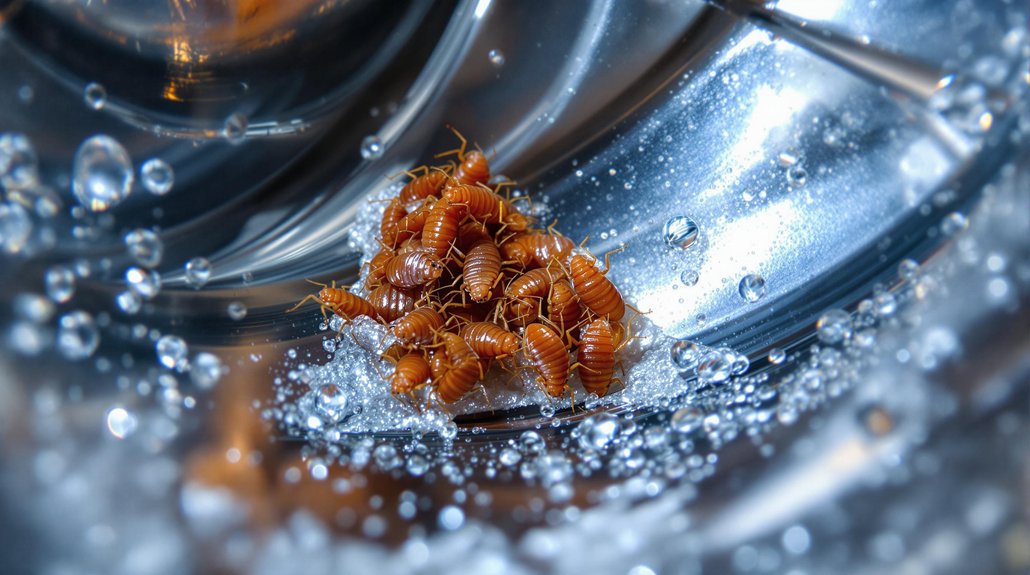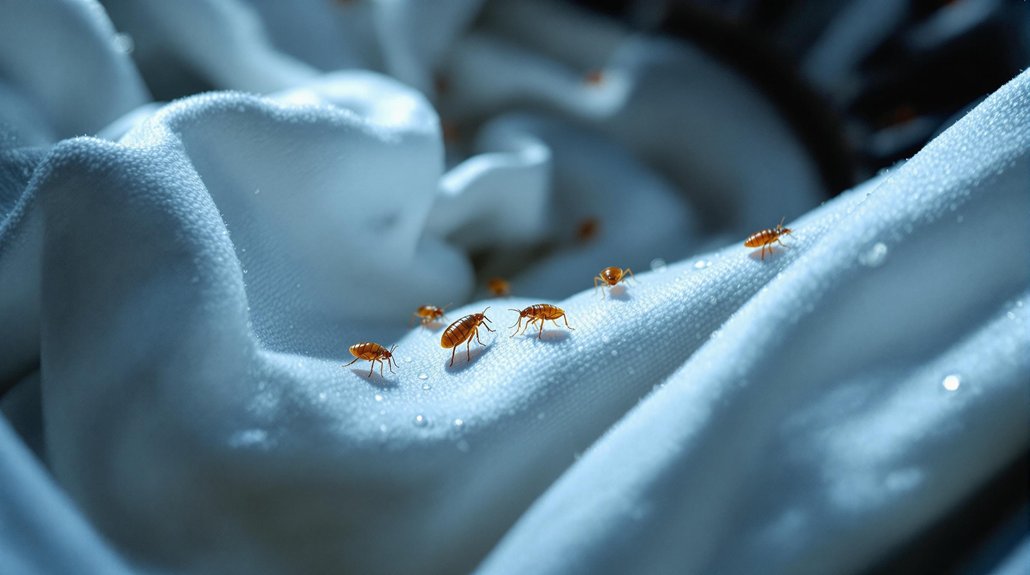
Bed bugs can sometimes survive washing machines if the water temperature is below 140°F, which isn’t hot enough to kill all stages. Washing in cooler water or at standard temperatures may only knock out some bugs but leave eggs and others alive. To fully eliminate bed bugs from laundry, high heat and proper drying are needed. If you’d like to know more about effective methods, there’s helpful info ahead.
Key Article Highlights
- Washing at temperatures below 120°F is typically ineffective, allowing bed bugs to survive.
- Temperatures of 140°F or higher fully kill all bed bug life stages, including eggs.
- Washing machines may not heat evenly, enabling some bed bugs or eggs to survive standard cycles.
- Cold or lukewarm water does not impact bed bugs, making such washes ineffective for eradication.
- Combining high-temperature wash cycles with additional methods like drying and steaming improves success.
Understanding Bed Bugs and Their Resilience

Bed bugs are small, flat insects that feed on human blood. Their anatomy allows them to hide easily in cracks and seams, making them hard to spot. They have a tough exoskeleton that provides protection against external threats. Bed bugs‘ survival mechanisms include their ability to enter a state of dormancy called nymph stages, which can last for months without feeding. They also can withstand a range of environmental conditions, such as low temperatures and limited access to food, demonstrating resilience. Their flat body shape helps them stay close to hosts and hide from predators or treatments. These biological features, combined with their ability to hide and endure tough conditions, make bed bugs difficult to eradicate completely. Understanding their anatomy and survival mechanisms is key to controlling infestations.
How Washing Temperatures Affect Bed Bugs
Washing clothes can be effective against bed bugs if the right temperature is used. Heat is key because bed bug resistance drops considerably at certain temperatures. Bed bugs exposed to water below 120°F have a good chance to survive, which reduces washing machine effectiveness. As a result, washing at 140°F or higher is recommended to kill all stages of bed bugs, including eggs.
| Temperature | Effectiveness | Bed Bug Resistance |
|---|---|---|
| Below 120°F | Less effective, some survive | High resistance |
| 120-130°F | Moderate, some eggs may survive | Moderate resistance |
| 140°F+ | Fully effective, kills all | No resistance |
Using high washing temperatures guarantees better results against bed bugs.
The Role of Detergents and Chemicals in Eliminating Bed Bugs

Detergents and chemicals can play a significant role in eliminating bed bugs during laundry. The effectiveness of detergents depends on their ability to break down bed bug exoskeletons and remove eggs, which requires proper formulation and concentration. Some detergents contain enzymes or ingredients designed to enhance pest removal, improving overall detergent effectiveness. However, chemical toxicity is a concern; many chemicals used in cleaning agents can be harmful to humans and pets if mishandled or overused. While detergents alone may not fully kill all bed bugs, especially eggs, combining them with high washing temperatures increases chances of success. Using the right detergent and understanding chemical toxicity are key to maximizing bed bug elimination during laundry, but they should be part of an integrated approach.
The Impact of Washing Cycles on Infested Items
The effectiveness of laundry chemicals and detergents often depends on the washing cycle used. Different cycles can influence how well bed bugs and their eggs are eradicated, making cycle choice a key part of effective laundry strategies.
Choosing the right washing cycle is crucial for effectively eliminating bed bugs and their eggs during laundry.
Here are three important points:
- Hot water cycles (above 130°F) are better at attacking bed bug behaviors like hiding and reproducing.
- Longer wash times increase the chances of bed bugs dying during the wash.
- High agitation levels help dislodge bed bugs from fabric fibers, improving chemical contact.
Understanding how washing cycles impact infested items is essential. Proper cycle selection can improve the chances of eliminating bed bugs, especially when considering their ability to hide and survive in different environments.
Can Bed Bugs Survive the Dryer?

Dryers can kill bed bugs if the temperature gets high enough. The desiccation process causes the bugs to dry out and die quickly. The length of the dryer cycle matters—longer cycles at high heat are more effective.
High Temperature Effectiveness
High temperatures in the dryer are usually effective at killing bed bugs and their eggs. The heat penetrates fabrics, reaching bed bugs hiding inside. To guarantee success, consider these key points:
- Maintain the dryer at 120°F (49°C) or higher for at least 20 minutes.
- Larger items may need longer cycles to reach the necessary temperature throughout.
- Regularly check that items are thoroughly dried on high heat, especially bedding and clothing.
This method is reliable because high temperature directly targets bed bugs, preventing their survival. It’s important to understand that brief or low-heat exposures won’t effectively eliminate the pests. Mastering the right temperature and cycle duration can greatly improve removal success.
Bed Bug Desiccation Process
Bed bugs die when they lose the moisture that keeps them alive, a process called desiccation. Their desiccation mechanisms include a waxy outer coating that helps retain water, but this barrier can be broken down by high heat. Without enough moisture, they cannot survive, making heat a key tool in eradication efforts. Bed bugs’ survival strategies include hiding in tight spaces and entering a state of dormancy, which can slightly delay desiccation. However, exposure to sufficiently high temperatures accelerates moisture loss and overwhelms their defenses. Consistent heat exposure guarantees the desiccation process is effective, as it prevents these insects from rehydrating or recovering. Mastering the focus on moisture loss is vital for effective bed bug control through thermal methods.
Dryer Cycle Duration
Running laundry cycles for enough time at sufficient heat can effectively kill bed bugs. The key is the dryer cycle effectiveness, which depends on the right duration and temperature. To master this process, consider these points:
- Use a high heat setting for at least 30 minutes to guarantee bed bugs are exposed to lethal temperatures.
- The ideal drying duration varies based on load size but generally should be a minimum of 30 minutes.
- Overloading the dryer can reduce heat efficiency, so dry smaller loads for better results.
Focusing on the ideal drying duration guarantees maximum effectiveness. Properly timed and heated cycles are essential to eliminate bed bugs and prevent re-infestation.
Effects of Freezing on Bed Bugs in Clothing and Fabrics
Freezing is a common method used to kill bed bugs in clothing and fabrics. When exposed to freezing temperatures of at least -0.4°F (-18°C) for four days, bed bugs and their eggs usually die. Cold treatment is effective across various fabric types, including cotton, wool, and synthetic materials. However, the success depends on how thoroughly the items are frozen and whether they are kept at that temperature consistently. Thicker fabrics may require longer exposure to guarantee complete eradication. Freezing is a chemical-free approach, making it safe and eco-friendly. For best results, clothing and fabrics should be placed in sealed plastic bags before freezing to prevent re-infestation. Proper freezing can greatly reduce bed bug populations on clothing and fabrics.
Limitations of Washing and Drying as a Standalone Treatment
Washing and drying can kill some bed bugs, but temperature thresholds are important—if the heat isn’t high enough, bugs can survive. Eggs that remain in clothes or fabrics also pose a risk, as they can hatch later. Plus, washing machines can’t reach all the places where bed bugs hide, limiting their effectiveness.
Temperature Thresholds Matter
Even though washing machines can kill some bed bugs, temperature thresholds are a real limit. Bed bugs need exposure to temperature extremes—specifically above 120°F (49°C)—to be reliably eradicated. Ordinary washing methods often don’t reach these temperatures evenly or for long enough. Here are key points to reflect on:
- Temperature Extremes: Washers may reach high temps in certain cycles, but uneven heating means some bugs can survive.
- Washing Methods: Using cold or lukewarm water won’t do much; only hot water can impact bed bugs effectively.
- Drying Duration: Dryers need to run at high heat for at least 20 minutes, but inconsistent heat distribution can allow some bed bugs to survive.
Remaining Eggs Pose Risk
While high temperatures can kill adult bed bugs, eggs can be a different story. Egg survival is tough because they often withstand washing and drying. Even if many eggs are removed, some may survive the process. These surviving eggs can hatch later, leading to a new infestation. Hatchling emergence occurs when eggs survive the treatment, making standalone washing and drying insufficient.
| Method | Egg Survival | Hatchling Risk |
|---|---|---|
| High-temperature wash | Possible | Yes |
| High-temperature dry | Possible | Yes |
| Cold or lukewarm treatment | Unlikely | Less likely |
| Using detergents | Variable | Possible |
| Treatment duration | Longer helps | Higher risk |
Limited Reach of Machines
Can washing machines and dryers fully eliminate bed bugs on their own? Not quite. Machine limitations can limit washing effectiveness, especially when it comes to reaching all hiding spots. Bed bugs often hide in cracks, crevices, and deep fabric folds that machines can’t target thoroughly.
Key challenges include:
- Limited reach — machines may not penetrate all hiding areas.
- Inconsistent heat and agitation — not all items reach lethal temperatures.
- Residual eggs and bugs — some eggs survive wash cycles, leading to future infestations.
While washing and drying are useful, they shouldn’t be solely relied on. Proper treatment requires additional measures to address these machine limitations and guarantee complete eradication.
Best Practices for Laundry to Control Bed Bug Spread
What are the best laundry habits to prevent the spread of bed bugs? Effective laundry organization is key. Keep infested clothes separate from clean items and transport them in sealed bags. Wash bedding, clothing, and linens regularly using hot water and high heat for drying, which can kill bed bugs and eggs. Proper fabric care involves following care labels, but for potentially infested items, prioritize thorough cleaning over delicate handling. Always empty pockets and inspect garments before washing. Using mattress and pillow protectors during laundry can also help contain bed bugs. Avoid reusing laundry baskets without cleaning them first. By maintaining organized laundry routines and applying proper fabric care, one can greatly reduce the risk of bed bugs spreading through clothing and bedding.
Complementary Methods to Eradicate Bed Bugs From Clothing
Beyond regular laundering, additional methods can help eliminate bed bugs from clothing more effectively. One effective approach is steam cleaning, which uses high temperatures to kill bed bugs and their eggs on fabric surfaces. It’s quick and can be done directly on clothing, especially for items that can’t withstand washing. Vacuum sealing is another useful method, trapping any remaining bed bugs or eggs inside a sealed bag, preventing them from spreading or surviving. This method works well for storing infested clothing or bedding. Combining these techniques with regular laundry creates a stronger defense against infestation. Using steam cleaning plus vacuum sealing guarantees you target bed bugs at different stages of their life cycle, boosting your chances of full eradication and mastery over the problem.
Preventing Re-infestation After Laundry Treatment
After completing laundry treatments, it’s important to take steps to prevent bed bugs from returning. Implementing effective preventive measures helps keep infestations from restarting. This includes sealing cracks and crevices, regularly vacuuming, and encasing mattresses and pillows with bed bug-proof covers. Ongoing monitoring is also essential. Use bed bug interceptors and check for signs of activity regularly. Removing clutter around sleeping areas reduces hiding spots. Maintaining cleanliness and inspecting laundry and bedding routinely helps catch any re-infestation early. These steps create a barrier against bed bugs and help guarantee that efforts to eliminate them are lasting. Consistent vigilance and preventive measures are key to avoiding re-infestation after laundry treatments. Staying proactive is the best way to keep bed bugs gone for good. Regular inspection and understanding of effective control methods can also enhance your prevention strategy.

